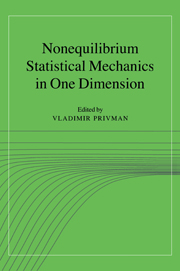Book contents
- Frontmatter
- Contents
- Contributors
- Preface
- Part I Reaction-Diffusion Systems and Models of Catalysis
- Part II Kinetic Ising Models
- Part III Ordering, Coagulation, Phase Separation
- Part IV Random Adsorption and Relaxation Processes
- Part V Fluctuations in Particle and Surface Systems
- Part VI Diffusion and Transport in One Dimension
- Part VII Experimental Results
- Index
- Abbreviations
Part V - Fluctuations in Particle and Surface Systems
Published online by Cambridge University Press: 18 December 2009
- Frontmatter
- Contents
- Contributors
- Preface
- Part I Reaction-Diffusion Systems and Models of Catalysis
- Part II Kinetic Ising Models
- Part III Ordering, Coagulation, Phase Separation
- Part IV Random Adsorption and Relaxation Processes
- Part V Fluctuations in Particle and Surface Systems
- Part VI Diffusion and Transport in One Dimension
- Part VII Experimental Results
- Index
- Abbreviations
Summary
Editor's note
Much interest has been devoted recently to various systems described in the continuum limit by variants of nonlinear diffusion equations. These include versions of the KPZ equation, Burgers’ equation, etc. Chapter 13 surveys nonlinear effects associated with shock formation in hard-core particle systems. Exact solution methods and results for such systems are then presented in Ch. 14.
Selected nonlinear effects in surface growth are reviewed in Ch. 15. Their relation to kinetic Ising models and a survey of some results were also presented in Ch. 4 (Sec. 4.6). This is a vast field with many recent results; see (and Chs. 4, 15) for review-type literature. Some surface-growth effects were also reviewed in Ch. 11.
The nonequilibrium ID systems covered in this book are effectively (1 + 1)- dimensional, where the second ‘dimension’ is time. For stochastic dynamics, the latter is frequently viewed as ‘Euclidean time’ in the field-theory nomenclature. Certain directed-walk models of surface fluctuations associated with wetting transitions, etc., as well as related models of polymer adsorption at surfaces, are effectively (0 + l)-dimensional in this classification, where the spatial dimension along the surface is effectively the Euclidean-time dimension. This property is shared by 1D quantum mechanics, to which the solution of many surface models reduces in the continuum limit. These models share simplicity, the availability of exact solutions, and the importance of fluctuations with the (l + l)-dimensional systems.
- Type
- Chapter
- Information
- Nonequilibrium Statistical Mechanics in One Dimension , pp. 261 - 262Publisher: Cambridge University PressPrint publication year: 1997



